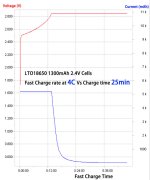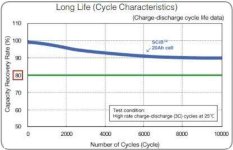Hummina Shadeeba said:
I don't think fast-charging is even necessarily detrimental. I've seen studies showing methods of fast charging, mainly high pulses, that have shown to destroy dendrites and even increase capacity in lithium or other chemistries.
PULSE CHARGING (PC)
Here is citation from the document "Aging of Lithium-Ion Batteries in Electric Vehicles" :
„ Other studies, however, showed that PC had no or even detrimental effects on the performance and cycle life of lithium-ion batteries [220 ,226]. Numerical simulations based on a 1D physicochemical model indicated that pulse charging with fixed frequency and fixed duty cycle does not have any advantages over CC charging with the same mean charging current [33 ,224]. Another study showed that for an identical mean current, losses rose and efficiency decreased with an increasing deviation of the charging current from a CC profile [220].“ ( page 75)
https://endless-sphere.com/forums/viewtopic.php?f=14&t=101500&p=1483921#p1483921
FAST CHARGING
Another citations from above-mentioned document :
„First of all, fast charging with high charging currents should not be applied for every-day use to avoid lithium plating and high stress for the electrode materials.“
„Results of Boost Charging and Supercharging
The BC and SC protocols apply a high charging current only at a certain SoC regime. Although it has
been beneficial to avoid high charging currents at high SoC regimes, where the anode potential is
lowest, the high charging currents have still caused disproportionate degradation at lower SoCs.“
(pages 105, 106)
Citation from Cleantechnica article about Tesla fast charging :
„Fast charging stresses a battery, and doing it too often or at too high a rate can shorten a battery’s useful life.“
„As Tesla explained, many things can reduce the lifespan of a battery pack, including charging at a high C rate.“
https://cleantechnica.com/2017/07/09/tesla-limiting-supercharging-rates-frequent-users/




